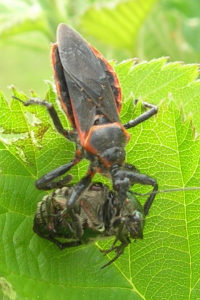Assassin bugs are also known as conenose, kissing and wheel bugs. There about 3000 different kinds of this insect and they vary widely in coloration but are all fairly similar in shape. The assassin bug as a whole is mostly beneficial feeding on insects such as mosquitos, flies and caterpillars or other harmful pests. Injecting a toxin which quickly paralyzes its prey is how it got its name. This insect is aggressive and will readily attack a perceived foe larger than itself. When left alone they are a benefit but certain kinds of assassin bugs known as the connose or kissing bugs feed on the blood of vertebrates which often includes humans. It is this type of assassin bug that is considered a pest and if bitten you can experience a very painful ordeal. Conenose bugs are known for biting at night when their prey are asleep and have the habit of biting around the mouth. (thus the kissing bug name) The welts are quite pronounced. Homes that are drafty such as older log cabins are often easy for this large bug to enter where they can be found in cracks or gaps and around sinks. Diseases such as Chagas are transmitted from the bites putting these bugs in the pest category.
How They Travel
This insect is able to fly and very adept at climbing. Some species are attracted to lights and easily find their way into homes via open doors. They are common in both north and south America and different varieties can be found worldwide.
How Best To Identify Assassin Bugs
The assassin bug takes on a variety of colors and markings but most are menacing in appearance. Noted for their ‘beak’ like proboscis and prominent eyes assassin bugs are insects with 6 legs, head thorax and abdomen. With their wings folded over their backs the colors often make very distinctive markings such as x’s or outlines that contrast with their usually dull body color. Life stages take one year to complete with five molts. Nymphs resemble the adults and need blood meals to advance to the next molt. There is one generation per year and single eggs are often laid in cracks and crevices.
prominent eyes assassin bugs are insects with 6 legs, head thorax and abdomen. With their wings folded over their backs the colors often make very distinctive markings such as x’s or outlines that contrast with their usually dull body color. Life stages take one year to complete with five molts. Nymphs resemble the adults and need blood meals to advance to the next molt. There is one generation per year and single eggs are often laid in cracks and crevices.
Treatment and Elimination
Exterior spraying for assassin bugs can be quite difficult. Treatment around doors, windows and light sources will be the most effective and at times a power spray of the surrounding grounds and shrubbery may be needed should populations build up. Bifen I/T will work for this type of exterior work. Dusting gaps, cracks and other entry points is key to stop those trying to enter in or females who are in search of a place to lay their eggs. Delta, Drione, DE (diamataceous earth) or Boric acid should do nicely. This insect is commonly found in crawl spaces  coming up through loose flooring or plumbing gaps so attention should be paid in this section of any home up off the ground. Since this bug is rather large in size you should at least attempt to seal up as many entry points as possible with caulks, tightening screens, door sweeps or other necessary methods. Reduced lighting can be very beneficial. Interior sprays using Tempo, Demand CS or Suspend SC as well as other labeled products will aid in control. Special care around sinks and dusting plumbing or other interior access points with the afore mentioned products will also be beneficial.
coming up through loose flooring or plumbing gaps so attention should be paid in this section of any home up off the ground. Since this bug is rather large in size you should at least attempt to seal up as many entry points as possible with caulks, tightening screens, door sweeps or other necessary methods. Reduced lighting can be very beneficial. Interior sprays using Tempo, Demand CS or Suspend SC as well as other labeled products will aid in control. Special care around sinks and dusting plumbing or other interior access points with the afore mentioned products will also be beneficial.




